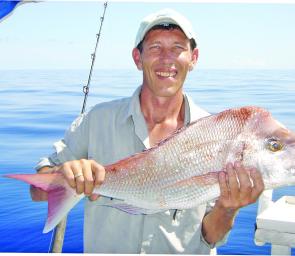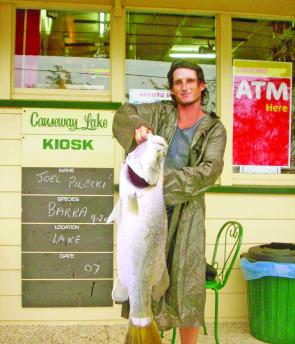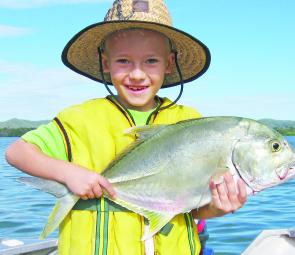May, with any luck should be the time of change, for both conditions and species. After a bad start to the year, our long-term forecasts have finally begun to look at little more appetising so I’ll begin with a list of options that will suit most anglers.
Let’s start from the bottom end of our range (only in proximity). The Fitzroy River will start to boil with blue and king salmon. As the temperatures drop these fish will increase in numbers. Try targeting the sand and mud banks on incoming tides with live bait; lures are a good backup. Any of the high banks heading downstream with access from the roads can do the job for the land-based anglers. Balaclava Island and Connors Creek are popular spots for the serious fishers. There are so many features and spots that anyone with time will find fish. Other fish around in numbers at the moment are bream, whiting, flathead and the odd black jew. Live bait is hard to find when the tide gets too high so either catch it on the way or fish the tides. Mud crabs will continue to fatten before shutting shop in June.
Keppel Sands to Emu Park and Coorooman Creek are the next stops moving north. Offshore anglers will have plenty to target including big grunter, cobia, mackerel and reefies at a variety of locations inside the 60km range. Liza Jane, Humpy and the old Fitzroy River basin should be holding stacks of fish thanks to their extensive reef structures. Liza Jane is a mackerel hotspot whenever the tide is about 4m and a 10am high. The closer islands such as Quartz off Keppel Sands and the Emu Park islands Wedge, Divided and Pelican to name a few, attract the lesser mackerels like a magnet. Much of the year they hold ribbonfish and pike for the bait chasers.
Coorooman Creek is well known for it’s muddies, whiting, grunter and salmon. Barramundi and fingermark do better here in the summer time. There are a lot of areas to fish and crab with obvious rock bars, sand banks and fallen timber providing cover for predators and bait schools. The sand banks around the mouth are whiting city particularly in the cooler months and flathead gather there in large numbers from June to October. Grunter prefer the deeper holes and cockle beds that you need a sounder to locate. Bait gathering is quite easy and when you put the boat in send your offsider down with the cast net while you park the car. More often than not there is no need to look anywhere else. Yabby beds are only accessible near the bottom of the tide. Beware of the rock bars up the back of Coorooman and Cawarral Creeks.
The Causeway Lake and entrance have a top name for quality fish and user friendliness. This is one of the best places to blood the kids into a fishing career while dad has the opportunity to nail a jack or barra at their feet. The entrance is popular with flathead and whiting fishers on the end of the run-out and early run-in. The Lake is a special location on the ‘run through’ tides over 3.8m. People line up across the bridge and along the front rock walls waiting for the tide to lift over the Causeway and as it rushes in it causes all the fish in the area to start feeding. Common catches include trevally, pike, mangrove jack, bream, cod and some of the biggest barramundi in Central Queensland at the right time of year. It is not uncommon for 15kg+ barra to be weighed-in at the Causeway Kiosk just over the road.
Rita Mada, located near the Causeway, is one of best mackerel haunts on the coast. From the rocky point to the bombies a couple of hundred metres from the beach, Rita Mada has accounted for its fair share of doggies, spotties and greys over the years.
Ironpot, Double Heads, Rosslyn Bay Harbour and Statue Bay make for the biggest diversity close to the main Yeppoon boat ramp. On a flat day you can’t count all the tinnies taking any one of the small mackerel species at Ironpot. At night when the mackerel go home, black jew come in and on the right night extra they will line up to nail a bait. Yeppoon’s and Double Heads jew holes are under a kilometre from the harbour ramp.
Fingermark, queenfish, salmon, cod, barramundi, bream, flathead and squid will be chasing schools of tailor and yorky herrings all over the harbour. When the yorkies flood into the harbour blue salmon go ape hitting anything that flashes in the light. Chromies are a vital piece of equipment on every trip to the harbour nailing everything from ribbonfish and salmon to the upper end of the food chain mackerels. Live bait is easy to get with a cast net from the jetties and wall. On a glassed off morning it is standing room only along the outside walls when the doggies come in. Take a tape because the babies usually arrive first.
Wreck Point, Stevensons Point and Bluff Rocks are places where fish moving up the coast from creek to creek stop. On the incoming tides bream, salmon and other school fishes make these spots attractive to the fishers without a boat. Occasionally a big barra or jew gets landed as a welcome by-catch. Yabbies are nearly always the pick of baits and can be pumped at Ross Creek within walking distance of these spots. Ross Creek has the honour of being in the heart of town and every time you pass the creek there is someone with a line in the water. Despite all the attention from families and other groups it keeps producing fish of surprising quality. If you see the oldies gathered on the beach in front of the local council chambers, bolt home and grab your whiting gear. More often than not if you don’t get a feed of whiting then flathead and bream take their place. High tide fishing from the front wall can be rewarding chasing salmon with pillies. Sometimes black jew to 15kg and over come in on the flood taking baits meant for much smaller critters. It is also one of the spots you can walk a crab pot in through the mangroves and expect a muddy or two.
Farnborough Beach and Barwells Creek go from Yeppoon to Corio Bay. This beach is similar to beaches down south with surf, banks and gutters. We don’t get many tailor but we do get blue salmon. They head up the beach and into Corio feeding on anything in the gutters on the way. It is hard to capture more than a couple before the school moves on to the next spot. These blues can be 2-4kg with one caught in 2001 pulling the scales to 9.5kg. Use a typical tailor type 3 hook rig and a pilchard or a heavy long shank hook with two yabbies hooked through the tail, both rigs with a long trace and a running sinker. Whiting and dart are there regularly and within a few moves can be located with little trouble.
Corio Bay up to Army country will be next issue as there is too much to cover in the May column.
Reads: 9152
Graham Edmunds caught this very early snapper near the Keppels.

Joe Pilecki landed this barramundi on a causeway run through.

Connor Duffy with a Causeway Lake trevally.




